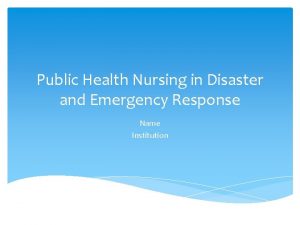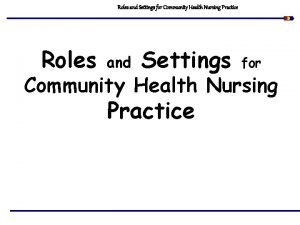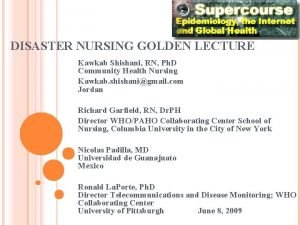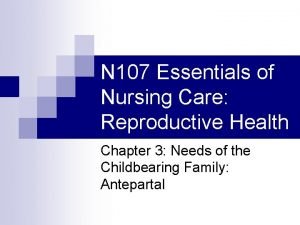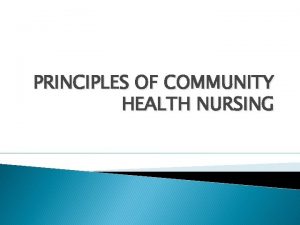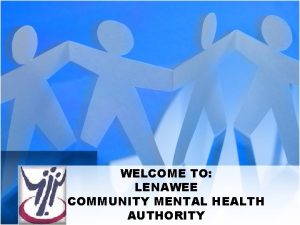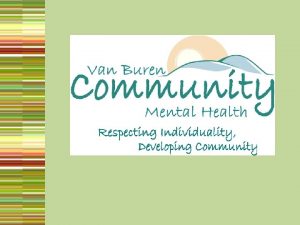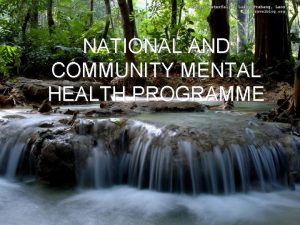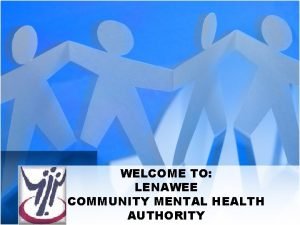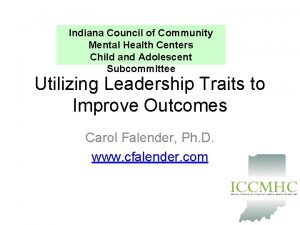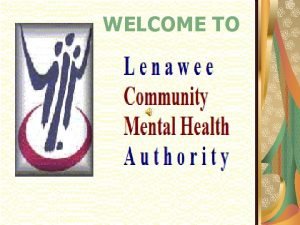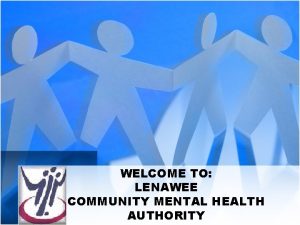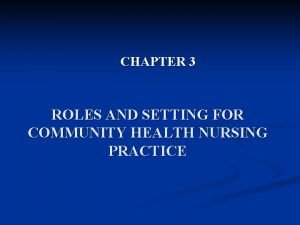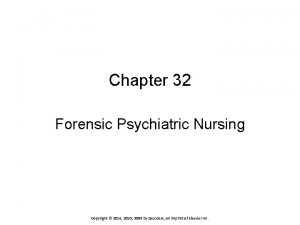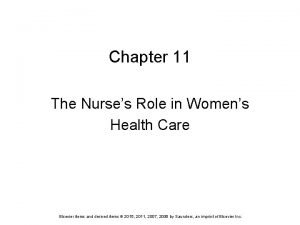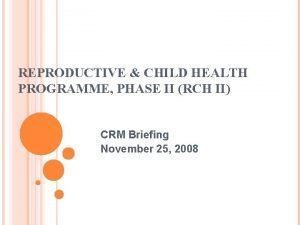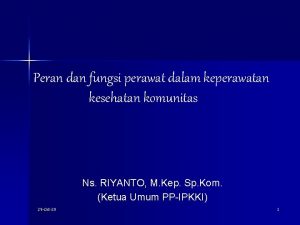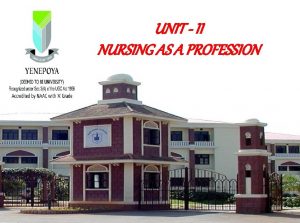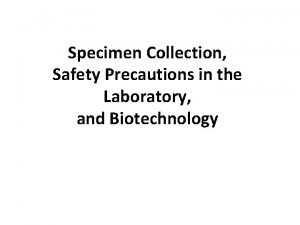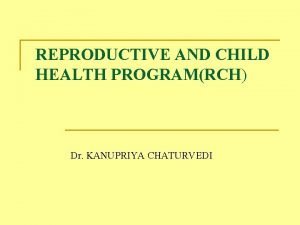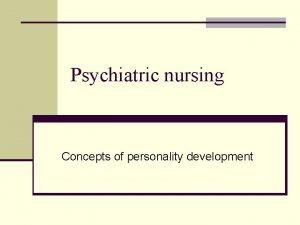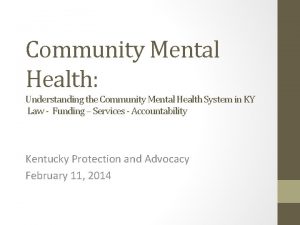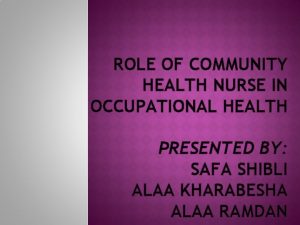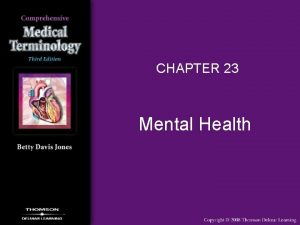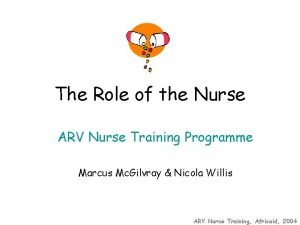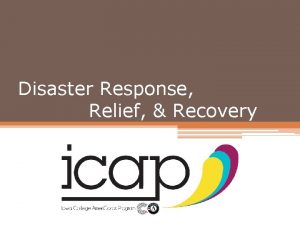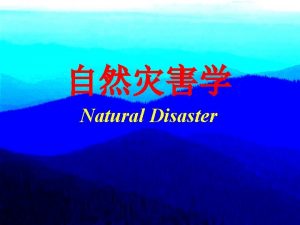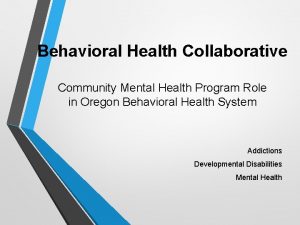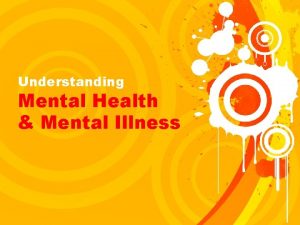ROLE OF COMMUNITY MENTAL HEALTH NURSE IN DISASTER





































- Slides: 37


ROLE OF COMMUNITY MENTAL HEALTH NURSE IN DISASTER MANAGEMENT

INTRODUCTION • Think globally and act locally holds true to disaster management. Disaster occurrence is a global phenomenon. It can occur at anywhere at any time. Disaster occurrence in any countries affects its health and economic conditions. Most types of natural disaster are apt to reoccur in the same areas or countries. • Furthermore with the changing ecosystem, deforestation, misuse of land we have every reason to believe that frequency of disasters such as floods, droughts will increase in the coming decades.

MEANING OF DISASTER • Disaster means a catastrophe, calamity or mishap, a grave occurrence which causes loss of life, human suffering, damage to and destruction of property degradation of environment which disrupts the normal functioning of societies, government communities and which adversely affects individual and families with severity and it is beyond the coping capacity of the community of the affected area.

DEFINITION OF DISASTER • “ Any occurrence that causes damage, economic disruption, loss of human life and deterioration in health and the health services on a scale sufficient to warrant an extra ordinary response from outside the affected community or area. ”

NATURAL DISASTER IN INDIA • Silent disaster of population explosion • HIV/AIDS bomb biological • Floods • Droughts • Earthquakes- Gujarat 2001 • Cyclone- Orissa 1999 • Landside of avalanches • Chemical disaster in Bhopal 1984 • Stampede • Fire accidents • Tsunami Dec 2004

CLASSIFICATION OF DISASTER • Water and climate related disasters • Geological related disasters • Biological related disasters • Chemical, industrial and nuclear disasters • Accident related disasters • Man made disasters.

WATER AND CLIMATE RELATED DISASTERS • Cyclones • Tornadoes and hurricanes • Hail storm • Sea erosion • Cloud burst • Heat wave and cold wave • Snow and volcanoes • Drought • Thunder and lightning

GEOLOGICALLY RELATED DISASTERS • Earthquakes • Landslides and mud flow • Dam failure/ Dam bursts • Mine fires

BIOLOGICALLY RELATED DISASTERS • Biological disasters and epidemics • Pest attacks • Cattle epidemics • Food poisoning

CHEMICAL, INDUSTRIAL AND NUCLEAR RELATED DISASTERS • Chemical and industrial disasters • Nuclear disasters

ACCIDENT RELATED DISASTERS • • • Forest fire Urban fire Mine flooding Oil spill Major building collapse Village fire Serial bomb blasts Festival related disasters Electrical disasters and fires Air, road and rail accidents Boat capsizing

MAN MADE DISASTERS • Population explosion • Wars and conflicts • Leaks from nuclear plants • Deforestation • Wide spread pollution to environment • Wide spread use of fossil fuel

EFFECTS OF DISASTERS GENERAL EFFECTS Loss of life Injury Damage of property Damage of cash Loss of lively hood Disruption of lifestyle Disruption of essential services Loss/disruption of infra structure • State economic loss • Sociological/psychological after effects • •

HEALTH EFFECTS • Accidents and trauma • Loss of life and disposal of dead bodies • Outbreaks of communicable diseases (water-borne) • Vector-borne diseases • Problems of malnutrition • Problems of psychological trauma • Problems of orphans and shelter

COMPONENTS OF DISASTER MANAGEMENT Disaster Preparedness Response Mitigation Rehabilitation Reconstruction

STEPS IN DISASTER MANAGEMENT • Search, rescue, and first aid • Field care • Triage Red color- immediate care Yellow color-care within 24 hrs Green color- ambulatory care Black color-dead people • Tagging -Printing a tag with all details • Care of the dead

RESPONSE • • Local people come first This consists of: Shelter and emergency settlement Water supply and sanitation Vector and pest control Control of communicable disease Prevention of out breaks Food supply

Nodal agency and organization DISASTER • • • Natural disaster Drought and drought relief Air accidents Railway accident Chemical disasters • Biological disasters • Nuclear disaster NODAL MINISTRY Ministry of home affair Ministry of agriculture Ministry of civil aviation Ministry of railways Ministry of environment and forests • Ministry of health • Dept. of atomic energy • • •

ADMINISTRATIVE STRUCTURE • Nodal agency for disaster management-ministry of home affairs • National Contingency Action Plan (Cap) - To facilitate launching of relief and rescue measures without delay • Various committees at the national level - Cabinet committee- for effective implementation of relief measures - National crisis management committee- headed by cabinet Co-ordinates activities of the central secretary. • Ministries and state Governments.

ROLE OF STATE GOVERNMENT-AUTONOMOUS Chief Secretary –consider infrastructure and guidance, Formulate action plans District collector – for directing supervising and monitoring relief Measures District relief committee-review of relief measures [Official and nonofficial members] ARMED FORCES OF THE COUNTRY

REHABILITATION BY HEALTH SECTOR – – – Water supply Food supply Improvement of sanitation Control of vectors Care of survivors, RECONSTRUCTION – – Setting up of shelter Health, food, and facilities in the campus Education Training of people/students/volunteers

MITIGATION • This involves measures to lessen the effects of emergency (eg. Improving the structural quality of schools houses and other buildings. • This compliments the disaster preparedness and disaster response activities.

PREPAREDNESS This consist of strengthening the capacity of a country to manage efficiently all types of emergency related to disaster. • The preparedness should – start from the community people – Training of health workers, social workers and members of Ngo’s etc. – In the form of money, manpower, and materials – A continuous, on-going multi sectored activity

MEASURES • • • Evaluation from the past experience Location of disaster prone areas Adaptation of a standard operatory procedure Organization of communication, information and warning systems Ensuring co-ordination and response mechanism Development of education program Co-ordination with news media National and international relations Organization of disaster stimulation exercises Keeping stock of foods, drugs, and other essential commodities

ROLE OF UNITED NATIONS AGENCIES • International Agencies WHO- UNICEF-FAO World food program (WFR) Office for the co-ordination of humanitarian affairs (OCHA)

Inter governmental organizations – European community humanitarian office (ECHO) – Organization of American states (OAS) – Centre of co-ordination for prevention of natural disasters in Central America – Caribbean disasters emergency response agency Non-governmental organizations – – Co-operational American relief everywhere (CARE) International committee of Red Cross International committee of voluntary agencies International federation of Red cross and Red Crescent societies (IFRC), etc

FACTORS AFFECTING SCOPE AND SEVERITY OF DISASTERS • Vulnerability of a population or individual • Environmental factors and type of impact (Physical, chemical, biological and social factors) • Warning time and proximity to disaster • Individual perception and response

DIMENSIONS OF DISASTER • • • Predictability e. g. ; earth Frequency Controllability Time Scope- and intensity

PHASES OF DISASTER • Pre impact phase • Impact phase • Post impact phase – Emergency phase – Recovery phase

PRINCIPLES OF DISASTERS MANAGEMENT (GARB&ENG-1969) • • Prevent the occurrence of the disaster whenever possible. Minimize the number of casualties. Prevent further casualties Rescue the victims. Provide first aid to the injured Evacuate the injured Provide definite medical care Promote reconstruction of lives

NURSES RESPONSIBILITY • • • PRE-PLANNING: developing a response plan All community medical and social agencies resources available Storage of equipment and supplies Follow the protocol of notification Designation of an alternative reporting site for health care workers Very familiar with the equipment and supplies to use Mock disaster drills Use of personal protective devices Knowledge on potential hazards at the disaster sites. e. g. : unstable building structure

COMMUNITY PREPAREDNESS • Education • First aid program • Making every home to store – – – – Emergency telephone numbers Battery operated radio Working flash light First aid kit Three day supply of water Medical information & family physician detail Persons to be notified in emergency

EMERGENCY RESPONSE • • • Personal concerns for health care providers Survey assessment Determining immediacy of care Role at emergency aid stations Major health concerns after a disaster Psychological needs of victims Recovery Personal response of care providers to disaster Ethical and legal implication

CONCLUSION Community health nurses are an integral part of disaster planning and implementation efforts. They are involved as planers, educators, direct care givers and assessment supervisors. They serve as a community survey assessors triage officers after the disaster has occurred. Hence participate actively in disaster management as a community health nurse and protect the health of the community by quality nursing care.

TAKE HOME MESSAGE • DISASTER CAN OCCUR AT ANY TIME • ANY FORM OR • ANY ARE • BE PREPARED TO MEET THE CHALENGES OF AFTER EFFECT OF DISASTER.

 Role of community mental health nurse
Role of community mental health nurse Role of occupational health nurse
Role of occupational health nurse Role of public health nurse in disaster response
Role of public health nurse in disaster response Responsibilities of community health nurse
Responsibilities of community health nurse Nurse role in disaster management
Nurse role in disaster management Mileu therapy
Mileu therapy Role of nurse in reproductive health ppt
Role of nurse in reproductive health ppt Principles of community nursing
Principles of community nursing Chapter 20 mental health and mental illness
Chapter 20 mental health and mental illness Mental health jeopardy questions and answers
Mental health jeopardy questions and answers Lenawee county cmh
Lenawee county cmh Van buren cmh
Van buren cmh Objectives of mental health programme
Objectives of mental health programme Lenawee community mental health
Lenawee community mental health Indiana council of community mental health centers
Indiana council of community mental health centers Scope of community mental health
Scope of community mental health Lenawee county community mental health
Lenawee county community mental health Lcmha
Lcmha Conclusion of community mental health nursing
Conclusion of community mental health nursing Community settings main roles
Community settings main roles Scrub nurse role
Scrub nurse role A nurse preceptor is orienting a newly licensed nurse
A nurse preceptor is orienting a newly licensed nurse What is the difference between mitigation and preparedness
What is the difference between mitigation and preparedness Roles of head nurse
Roles of head nurse Role of psychiatric nurse
Role of psychiatric nurse Chapter 11 the nurse's role in women's healthcare
Chapter 11 the nurse's role in women's healthcare Type of admission
Type of admission Reproductive and child health programme phase 1
Reproductive and child health programme phase 1 Peran dan fungsi perawat komunitas
Peran dan fungsi perawat komunitas Maintaining records and reports
Maintaining records and reports Nurses responsibility in sterilization
Nurses responsibility in sterilization What is nursing definition
What is nursing definition Role of nurse in behaviour therapy ppt
Role of nurse in behaviour therapy ppt Safety precautions in blood collection
Safety precautions in blood collection Role of nurse in specimen collection slideshare
Role of nurse in specimen collection slideshare Components of rch phase 1
Components of rch phase 1 Role of nurse in group therapy
Role of nurse in group therapy Splint incision
Splint incision


